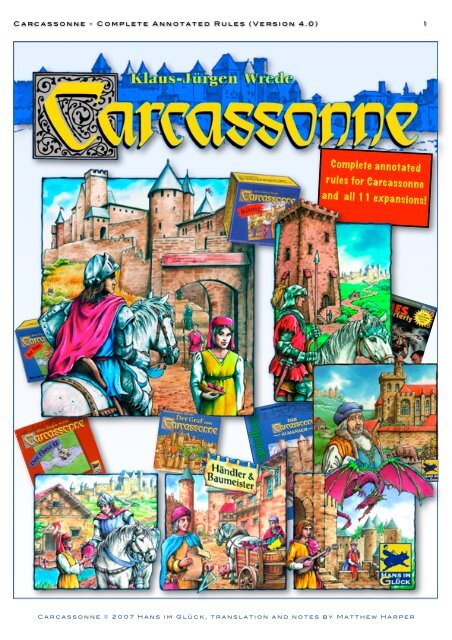

: 13 In general (see table), points are awarded for the number of tiles covered by a feature a completed cloister scores nine points for the cloister plus eight neighboring tiles. : 12 Once a city, cloister, or road feature is scored, all of the followers in that feature are returned to their owners.
#CARCASSONNE RULES ENGLISH PDF FULL#
If there is a tie for the most followers in any given feature, all of the tied players are awarded the full number of points. Points are awarded to the players with the most followers in a feature. : 10Ĭities are completed when they contain no unfinished edges from which they may be expanded, roads are similarly completed when they have closed both ends or form a loop, and cloisters are completed when surrounded by eight tiles. The stationing phase of the turn was completed by claiming the completed feature. A player may complete a feature by drawing placing a tile, claim it by stationing a follower on the newly-placed tile, and receive the score for completing it all in the same turn, but the sequence of that turn means the player cannot redeploy the follower after it is returned to their stock. ĭuring each player's turn, completed cities, cloisters, and roads (but not fields) are scored before that player's turn ends. The player with the most points wins the game. At that time, all incomplete features (including fields) score points for the players with the most followers on them. The game ends when the last tile has been placed.

Each player has eight followers since one is used to keep track of the player's score, only seven can be in play at any moment. If any feature (except a field) is completed during a player's turn, the score for the completed feature is counted for the player that controls that feature after scoring, the controlling "meeple" is removed from the board and returned to the player's stock. For example, two separate fields (each with a follower/farmer) can become connected into a single field subsequently by a newly-placed terrain tile. It is possible for terrain features to become "shared" by opposing players when tile(s) are placed in subsequent turns that connect previously unconnected features. When stationing a follower, the marker is placed upright on the feature to claim that feature, except for a field, where the follower is laid down instead to emphasize that fields are not scored until the end of the game the follower's role depends on the feature claimed, changing from thief/highwayman ( road) to knight ( city), monk ( cloister or monastery), or farmer ( field). However, if the feature is connected to a feature already claimed by another player, the follower cannot be stationed on that feature. : 8–9 A follower (or " meeple") on a tile, showing the walls and buildings of the townĪfter placing each newly drawn tile, the placing player may opt to station a marker (called a "follower" or "meeple") on a terrain feature (i.e., a road, city, cloister, or field) of that newly placed tile to claim control of it. If the newly-drawn tile cannot be placed anywhere legally, the players may choose to remove the tile from the game, or return it to the draw pile. A cloister tile may be placed adjacent to another cloister tile, as there are no connecting features. Connections are made across adjacent edges only corners do not connect. The new tile must be placed in a way that extends terrain features on the tiles it touches: roads must connect to roads, fields to fields, and cities to cities. To start each turn, a player draws a new terrain tile and places it adjacent to tiles that are already face up. Score completed feature(s) (if relevant).Station a follower on the newly-placed tile (optional).Each player's turn consists of three distinct phases: The game starts with a single specific terrain tile face up and 71 others shuffled face down for the players to draw from.

The game board is a medieval landscape built by the players as the game progresses. Gameplay The CRFR starting tile has three features: a single city edge, a straight road parallel to that edge, and the field occupying the remainder tile notation describes the features on each edge, clockwise from the north A new edition, with updated artwork on the tiles and the box, was released in 2014. The game has spawned many expansions and spin-offs, and several PC, console and mobile versions. It is named after the medieval fortified town of Carcassonne in southern France, famed for its city walls. It received the Spiel des Jahres and the Deutscher Spiele Preis awards in 2001. Carcassonne ( / ˌ k ɑːr k ə ˈ s ɒ n/) is a tile-based German-style board game for two to five players, designed by Klaus-Jürgen Wrede and published in 2000 by Hans im Glück in German and by Rio Grande Games (until 2012) and Z-Man Games (currently) in English.


 0 kommentar(er)
0 kommentar(er)
